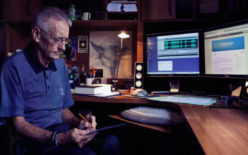On August 28, 2011, as part of its 9/11 remembrance series, National Geographic aired a one-hour special, “George W. Bush: The 9/11 Interview.” Here is my initial perspective.
Overview
President Bush’s presentation was not an interview, it was a remembrance. The remembrance was presidential in tone, as expected, and chronological in presentation. He established a simple theme, “protect the nation,” and stayed on theme throughout the hour-long memoir. Along the way he set a controversial high bar for historians on at least four essential points. He concluded with the announcement of the killing of Osama bin Laden, a president-to-president passing of the torch of leadership for the war on terror to President Obama.
Setting the bar for history
Shootdown authority. President Bush established that a first order of business on board Air Force One was to provide the Air Force the authority it needed, if necessary, to shootdown other hijacked aircraft. He is clear that he passed that authority before he learned that United Airlines flight 93 was down and that he was concerned when he learned that news. The President provided no elaboration and never mentioned the national command authority or Vice President Cheney. He has concluded, for history, that he, alone, issued the order. That is his retrospective internalization and statement for the record and for history.
Iraq. President Bush established that September 15, 2001, at Camp David, was the first serious discussion about Iraq. His decision at that time was to deal with that issue later on. He did not elaborate and did not return to the subject. Here, especially, he stuck to his protect the nation theme and said that all his decisions were to protect the country. He did his duty as a wartime president.
PEOC. He mentioned this subject after a video clip of his motorcade to the airport at Sarasota, screen-stamped at 9:35. He stated that Condi Rice, who was there, called him with the report that a hijacked plane had struck the Pentagon. He did not mention the Vice President.
The threat, what he knew, and what to do about the intelligence community. The President said that his morning security briefing was “nothing out of the ordinary.” After the events of the day he thought about why we didn’t know about this. The August 6 PDB was shown on screen but the President did not speak to it. Again, he stuck to his theme and said that we had a job to do and we needed the intelligence Community. We needed the community to look forward, not backward. The strong implication was that there was not a need to look at the mistakes that were made.
Other points of interest
Some have argued that the President somehow, someway should have gotten involved with the counterattack, the immediate defense. That is not what President’s are paid to do. President Bush’s job was to speak to the nation. The screen stamps show that the President was in the holding room at 9:25 and spoke to the nation at 9:30. In that same time frame the FAA’s primary net was activated, the NMCC’s Significant Event Conference was convened, and the Secure Video Television System (SVTS) was activated. The President was not involved with any of them, nor should he have been.
I have previously written that the job of the President is to protect the country and the job of the Secret Service is to protect the President. On the morning of 9/11 those two jobs became mutually exclusive, as the President described. He wanted to go to Washington; the Service, the military, and Andrew Card said no. There was a threat to the White House, a background voice said, as the President described the ascendance of Air Force One over Florida. A previous screen stamp showed 9:58. Air Force One turned west at 10:10. The Langley fighters reached Washington at 10:00 and by 10:07 one of them became the threat to the White House. The President aquiesced and did not put his foot down as Commander in Chief until after he reached Offutt Air Force Base.
